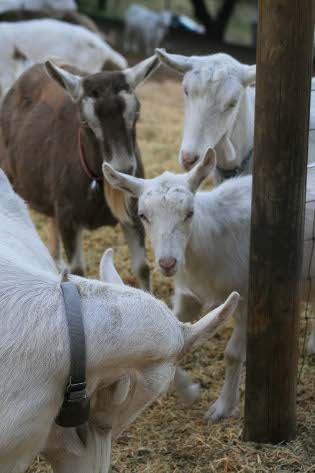R-CALF United Stockgrowers of America
“Fighting for the U.S. Cattle Producer”
For Immediate Release Contact: Shae Dodson, Communications Coordinator
August 3, 2009 Phone: 406-672-8969; e-mail: sdodson@r-calfusa.com
USDA Partners with Private Company to Help Sell Ear Tags
to U.S. Farmers and Ranchers
Billings, Mont. – The U.S. Department of Agriculture (USDA) has partnered with Allflex, a private multinational firm that manufactures and sells ear tags in more than seven countries, to help Allflex market, promote and sell ear tags to U.S. cattle producers. Both USDA and Allflex contributed $10,000 or more to become “Platinum Level” sponsors of the private industry conference ID∙INFO EXPO 2009 to be held August 25-27 at the Westin Crown Center in Kansas City, Mo. Among the stated purposes of the conference is to further participation in USDA’s National Animal Identification System (NAIS), a program that would significantly increase the market demand for ear tags.
“This is a perfect example of how USDA is inappropriately using taxpayer dollars to further the interests of private multinational companies,” said R-CALF USA President/Region VI Director Max Thornsberry, a Missouri veterinarian who also chairs the group’s animal health committee. “This huge contribution clearly shows that USDA is catering to the interests of multinational corporations to the exclusion of the hard-working men and women who are being besieged both by ear tag companies and USDA to force them to comply with NAIS.”
In each of the 14 NAIS listening sessions held throughout the U.S. during May through June, overwhelming opposition was raised by U.S. farmers and ranchers against the USDA’s NAIS program.
“Despite this overwhelming opposition, and despite repeated pleas from U.S. farmers and ranchers that USDA cease catering to the interests of multinational corporations and begin listening to the concerns of U.S. citizens, the agency obviously is forging ahead to help its corporate friends,” Thornsberry said.
“Allflex is among a select list of USDA-authorized ear tag manufacturers, so its help from USDA to boost demand for ear tags under NAIS is certain to boost the company’s marketing opportunities,” he added. “We are appalled by USDA’s brazen financial partnership with Allflex and urge Congress to immediately cut all further funding to USDA for the purpose of promoting NAIS.”
# # #
R-CALF USA (Ranchers-Cattlemen Action Legal Fund, United Stockgrowers of America) is a national, non-profit organization dedicated to ensuring the continued profitability and viability of the U.S. cattle industry. R-CALF USA represents thousands of U.S. cattle producers on trade and marketin! g issues. Members are located across 47 states and are primarily cow/calf operators, cattle backgrounders, and/or feedlot owners. R-CALF USA directors and committee chairs are extremely active unpaid volunteers. R-CALF USA has dozens of affiliate organizations and various main-street businesses are associate members. For more information, visit www.r-calfusa.com or, call 406-252-2516.




 Mr. Hentges is a 1992 graduate of the University of Texas with a juris doctorate from the School of Law and a Master of Public Affairs from the Lyndon B. Johnson School of Public Affairs. He is a 1987 graduate of Oklahoma State University with a bachelor of science in agricultural economics.
Mr. Hentges is a 1992 graduate of the University of Texas with a juris doctorate from the School of Law and a Master of Public Affairs from the Lyndon B. Johnson School of Public Affairs. He is a 1987 graduate of Oklahoma State University with a bachelor of science in agricultural economics. “The first thing they did when they got the authority to write rules … was to grant themselves the authority to conduct warrantless searches. Wisconsin is in the process of coercing farmers and backyard producers … into NAIS, and the accompanying Premises ID program, by threatening to withhold any of the licenses they control.” Paul Griepentrog
“The first thing they did when they got the authority to write rules … was to grant themselves the authority to conduct warrantless searches. Wisconsin is in the process of coercing farmers and backyard producers … into NAIS, and the accompanying Premises ID program, by threatening to withhold any of the licenses they control.” Paul Griepentrog Although there is a bill in Wisconsin which would restore voluntary participation I feel it is nothing more than an attempt at political redemption by the same people who passed the mandatory bill to begin with, in that they are fully aware that this bills will be sent to the House Ag committee and never see the light of day. This is merely political posturing…. The house, senate and government are all controlled by Democrats. This may be nothing more than a smoke screen while they make mandatory phase II which is the tagging and chipping, which can’t be done unless you have a Premises ID.
Although there is a bill in Wisconsin which would restore voluntary participation I feel it is nothing more than an attempt at political redemption by the same people who passed the mandatory bill to begin with, in that they are fully aware that this bills will be sent to the House Ag committee and never see the light of day. This is merely political posturing…. The house, senate and government are all controlled by Democrats. This may be nothing more than a smoke screen while they make mandatory phase II which is the tagging and chipping, which can’t be done unless you have a Premises ID.